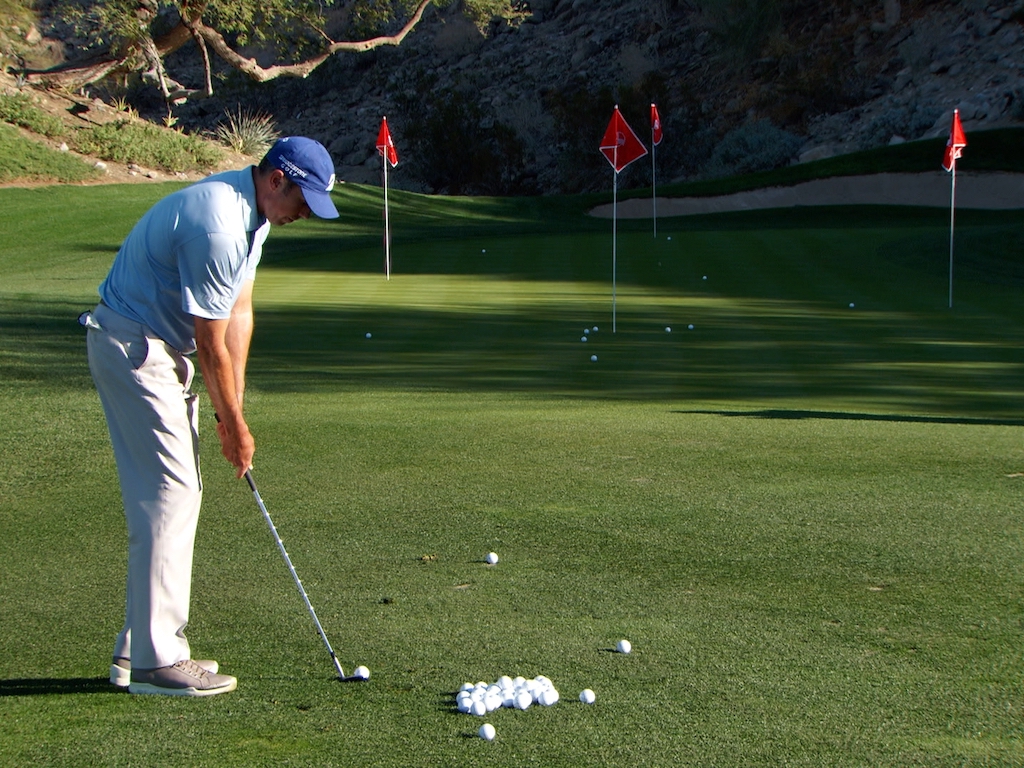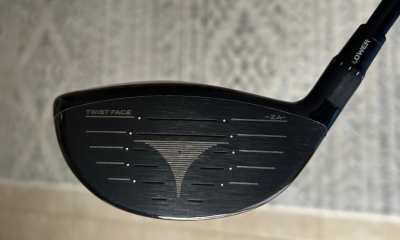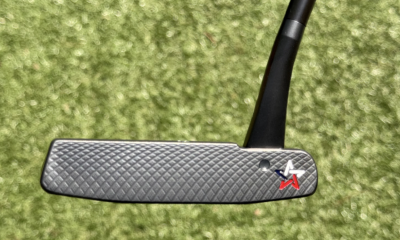Instruction
The Wedge Guy: Engage your core for better wedge play

As I am getting to know a new group of golf buddies since I moved to a new club this past summer, I have the fun of observing all these new swings and techniques. What I see most often is plenty of struggles around the greens.
What I see most often in mid-to high-handicap players (and some low handicap ones) is a technique that is overly dependent on hand action, where body core rotation is practically non-existent. This causes the golfer to make a slap or jab at the ball with the clubhead in an attempt to make contact.
This reliance on your hands is then aggravated by one or two shots that are hit poorly, thereby making you more “impact conscious.” And the vicious cycle begins – bad shot, more handsy, another bad shot, tighter grip, another bad shot, quicker tempo, and holes just thrown away.
Years ago, I created a simple drill to feel how your body core should be engaged, even on short scoring shots, so you can try to cure this terrible affliction.
Pick up a wedge and take your normal grip. Now hold it directly in front of you, with your upper arms relaxed at your side and your elbows bent so your forearms are parallel to the floor and right in front of your chest. The club should be vertical, so that you are looking right at your right thumbnail (for right-handers). Now, keep your eyes focused on your right thumbnail and your upper arms close to your chest, rotate your upper body to move your hands and the club back and forth, starting about a foot in either direction. You want to feel like nothing is moving but your body core. As you continue to rotate back and through, lengthen the range of motion until you are making nearly a full shoulder turn. But always make sure that your hands are right in front of your sternum throughout the range of motion.
Now, extend your arms straight out in front of you, so that now the club is pointing away from you at about 45 degrees. Repeat the drill, moving the arms and club back and through only by rotating your body core. It helps to focus your eyes on the right thumb so that you are very aware if you start swinging the arms without rotating the body. That’s what a pitching swing should feel like – one-piece rotation of the body, with the arms and hands “quiet.”
The last piece of the puzzle is to gradually lower the club as you rotate back and through – do this by bending at the hips, flexing the knees and lowering the hands. Lower the club a little bit on each rotation, so that you continue to feel like the body core is driving the entire action. Once you get so that the club is brushing the turf or carpet as you go back and through, you will be feeling what a solid, functional and repeatable wedge swing should feel like.
I realize this is abbreviated but try it and I think you will see just how inactive your body might have been on your pitch shots.
- LIKE111
- LEGIT12
- WOW4
- LOL7
- IDHT0
- FLOP2
- OB1
- SHANK11
Instruction
Clement: Laid-off or perfect fade? Across-the-line or perfect draw?

Some call the image on the left laid off, but if you are hitting a fade, this could be a perfect backswing for it! Same for across the line for a draw! Stop racking your brain with perceived mistakes and simply match backswing to shot shape!
- LIKE0
- LEGIT0
- WOW0
- LOL0
- IDHT0
- FLOP0
- OB0
- SHANK1
Instruction
The Wedge Guy: The easiest-to-learn golf basic

My golf learning began with this simple fact – if you don’t have a fundamentally sound hold on the golf club, it is practically impossible for your body to execute a fundamentally sound golf swing. I’m still a big believer that the golf swing is much easier to execute if you begin with the proper hold on the club.
As you might imagine, I come into contact with hundreds of golfers of all skill levels. And it is very rare to see a good player with a bad hold on the golf club. There are some exceptions, for sure, but they are very few and very far between, and they typically have beat so many balls with their poor grip that they’ve found a way to work around it.
The reality of biophysics is that the body moves only in certain ways – and the particulars of the way you hold the golf club can totally prevent a sound swing motion that allows the club to release properly through the impact zone. The wonderful thing is that anyone can learn how to put a fundamentally sound hold on the golf club, and you can practice it anywhere your hands are not otherwise engaged, like watching TV or just sitting and relaxing.
Whether you prefer an overlap, interlock or full-finger (not baseball!) grip on the club, the same fundamentals apply. Here are the major grip faults I see most often, in the order of the frequency:
Mis-aligned hands
By this I mean that the palms of the two hands are not parallel to each other. Too many golfers have a weak left hand and strong right, or vice versa. The easiest way to learn how to hold the club with your palms aligned properly is to grip a plain wooden ruler or yardstick. It forces the hands to align properly and shows you how that feels. If you grip and re-grip a yardstick several times, then grip a club, you’ll see that the learning curve is almost immediate.
The position of the grip in the upper/left hand
I also observe many golfers who have the butt of the grip too far into the heel pad of the upper hand (the left hand for right-handed players). It’s amazing how much easier it is to release the club through the ball if even 1/4-1/2″ of the butt is beyond the left heel pad. Try this yourself to see what I mean. Swing the club freely with just your left hand and notice the difference in its release from when you hold it at the end of the grip, versus gripping down even a half inch.
To help you really understand how this works, go to the range and hit shots with your five-iron gripped down a full inch to make the club the same length as your seven-iron. You will probably see an amazing shot shape difference, and likely not see as much distance loss as you would expect.
Too much lower (right) hand on the club
It seems like almost all golfers of 8-10 handicap or higher have the club too far into the palm of the lower hand, because that feels “good” if you are trying to control the path of the clubhead to the ball. But the golf swing is not an effort to hit at the ball – it is a swing of the club. The proper hold on the club has the grip underneath the pad at the base of the fingers. This will likely feel “weak” to you — like you cannot control the club like that. EXACTLY. You should not be trying to control the club with your lower/master hand.
Gripping too tightly
Nearly all golfers hold the club too tightly, which tenses up the forearms and prevents a proper release of the club through impact. In order for the club to move back and through properly, you must feel that the club is controlled by the last three fingers of the upper hand, and the middle two fingers of the lower hand. If you engage your thumbs and forefingers in “holding” the club, the result will almost always be a grip that is too tight. Try this for yourself. Hold the club in your upper hand only, and squeeze firmly with just the last three fingers, with the forefinger and thumb off the club entirely. You have good control, but your forearms are not tense. Then begin to squeeze down with your thumb and forefinger and observe the tensing of the entire forearm. This is the way we are made, so the key to preventing tenseness in the arms is to hold the club very lightly with the “pinchers” — the thumbs and forefingers.
So, those are what I believe are the four fundamentals of a good grip. Anyone can learn them in their home or office very quickly. There is no easier way to improve your ball striking consistency and add distance than giving more attention to the way you hold the golf club.
More from the Wedge Guy
- The Wedge Guy: Golf mastery begins with your wedge game
- The Wedge Guy: Why golf is 20 times harder than brain surgery
- The Wedge Guy: Musings on the golf ball rollback
- LIKE87
- LEGIT13
- WOW6
- LOL1
- IDHT0
- FLOP4
- OB1
- SHANK8
Instruction
Clement: Stop ripping off your swing with this drill!

Not the dreaded headcover under the armpit drill! As if your body is defective and can’t function by itself! Have you seen how incredible the human machine is with all the incredible feats of agility all kinds of athletes are accomplishing? You think your body is so defective (the good Lord is laughing his head off at you) that it needs a headcover tucked under the armpit so you can swing like T-Rex?
- LIKE0
- LEGIT2
- WOW2
- LOL0
- IDHT0
- FLOP0
- OB0
- SHANK2
-

 19th Hole2 weeks ago
19th Hole2 weeks agoDave Portnoy places monstrous outright bet for the 2024 Masters
-

 19th Hole5 days ago
19th Hole5 days agoJustin Thomas on the equipment choice of Scottie Scheffler that he thinks is ‘weird’
-

 19th Hole3 weeks ago
19th Hole3 weeks agoTiger Woods arrives at 2024 Masters equipped with a putter that may surprise you
-

 19th Hole4 days ago
19th Hole4 days ago‘Absolutely crazy’ – Major champ lays into Patrick Cantlay over his decision on final hole of RBC Heritage
-

 19th Hole2 weeks ago
19th Hole2 weeks agoTwo star names reportedly blanked Jon Rahm all week at the Masters
-

 19th Hole2 weeks ago
19th Hole2 weeks agoReport: LIV Golf identifies latest star name they hope to sign to breakaway tour
-

 19th Hole2 weeks ago
19th Hole2 weeks agoNeal Shipley presser ends in awkward fashion after reporter claims Tiger handed him note on 8th fairway
-

 19th Hole1 week ago
19th Hole1 week agoBrandel Chamblee has ‘no doubt’ who started the McIlroy/LIV rumor and why
























Vii Pii
Nov 22, 2021 at 5:40 pm
Pictures would be helpful.
No Donkeys Allowed
Nov 8, 2021 at 12:11 pm
Kdouuuuuuche, Kdouuuuuuche, Kdouuuuuuuche, Kdouuuuuuuuche,Kdouuuuuuuuuuuuche, Kdouuuuuuuuuche, Kdouuuuuuuuuuuuuche….
ChipNRun
Nov 5, 2021 at 12:09 pm
Terry,
Players who don’t use the core often do well on “straight back-straight through” chip and run shots. But, they often have erratic wedge games because SBST doesn’t generate power for longer pitch (lofted) shots.
dkash
Nov 4, 2021 at 1:35 pm
Tell Stan Utley that…..
Vinnieluvv
Nov 3, 2021 at 6:24 pm
Engaging your core also protects your back. I also do it more now when putting and it definitely helps keep the back from flaring up.
geohogan
Nov 3, 2021 at 5:08 pm
Our lower body needs to adjust to change in balance the movement
of weight of our arms(25-40 pounds) causes even in small pitches.
If we start from the ground up ie with our feet, our cores will automatically be engaged.
Acemandrake
Nov 3, 2021 at 3:47 pm
Tom Kite said he was a good wedge player because he kept the butt end of the club pointing at his belly button throughout the swing.
He also said he’d be really good if he could do that with all his clubs.